This post will show you how to land marketing partnerships that instantly put your business in front of thousands of your ideal customers.
You’re going to learn how to get influential companies and people in your industry to:
- Interview you on their podcasts
- Email their list about your business
- Book you for a partner webinar, Facebook Live session, or other type of live presentation
And you’ll be able to do it even if, right now, they have no idea who you are. 🙂
But first—what do we mean when we say “partnerships”?
They might sound fancy, but in reality partnerships are pretty straightforward…and you might even already be executing them in your own business.
A partnership is when you provide something valuable to a company, and they promote you to their audience in return. That’s it.
Think of a partnership like being the opening act for a popular band:
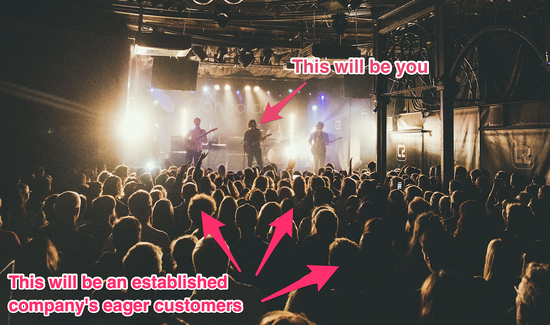
It’s one of the most effective ways to rapidly build your audience or increase sales.
In fact, the first year we made partnerships our top marketing priority, our email subscriber count grew from 50 to 500 per day and sales increased 48%.
In this marketing makeover, I’m going to give you our playbook for booking partnerships by showing you exactly how another business could implement it.
It doesn’t involve any fancy marketing initiatives.
No sponsorships or influencer marketing or product placement deals.
No co-marketing or co-branding or joint products or affiliate marketing strategies that cut into your bottom line.
Just step-by-step instructions on how you can get in front of other people’s audiences (in a way that makes the other business owner look great, too) to convert them into new customers.
Meet Sarah Doody.
Sarah is the creator of UX Portfolio Formula, an online course that helps UX designers advance their careers. She also offers UX career coaching.
This post is going to show you how a business like Sarah’s could start with a small partnership and then “stair step” up to bigger and better ones:
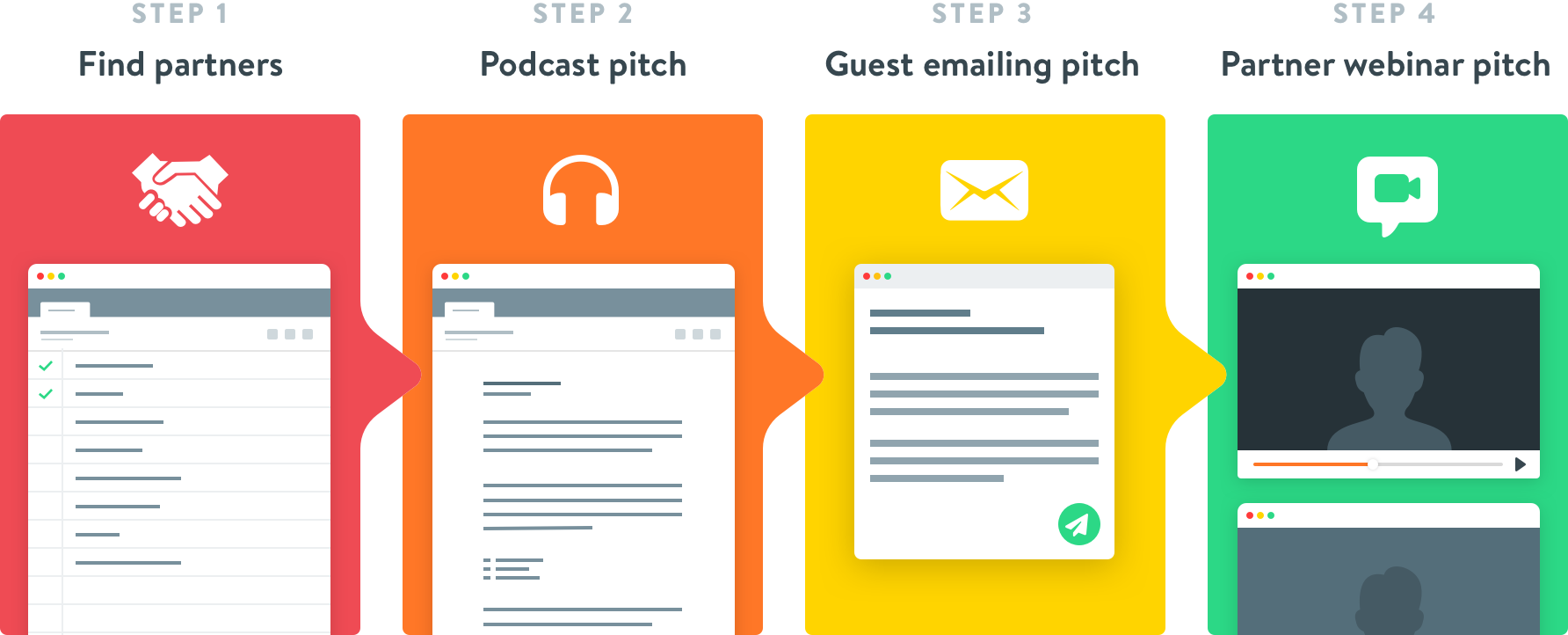
In each step, I’ll walk you through our approach by making a partnership marketing plan for Sarah’s business as an example.
By the end, you’ll have everything you need to attract thousands of leads to your business using 3 simple types of partnerships.
 Get it Free Free Download: Get our collection of partnership pitch examples, self-scoring partner spreadsheets, and an email pitch checklist so you can start booking partnerships today.
Get it Free Free Download: Get our collection of partnership pitch examples, self-scoring partner spreadsheets, and an email pitch checklist so you can start booking partnerships today.
Editor’s Note: This post was originally published on 1/9/20 and updated on 11/20/20.
Step 1: Identify Your Ideal Partners by Making a “Dream 50”
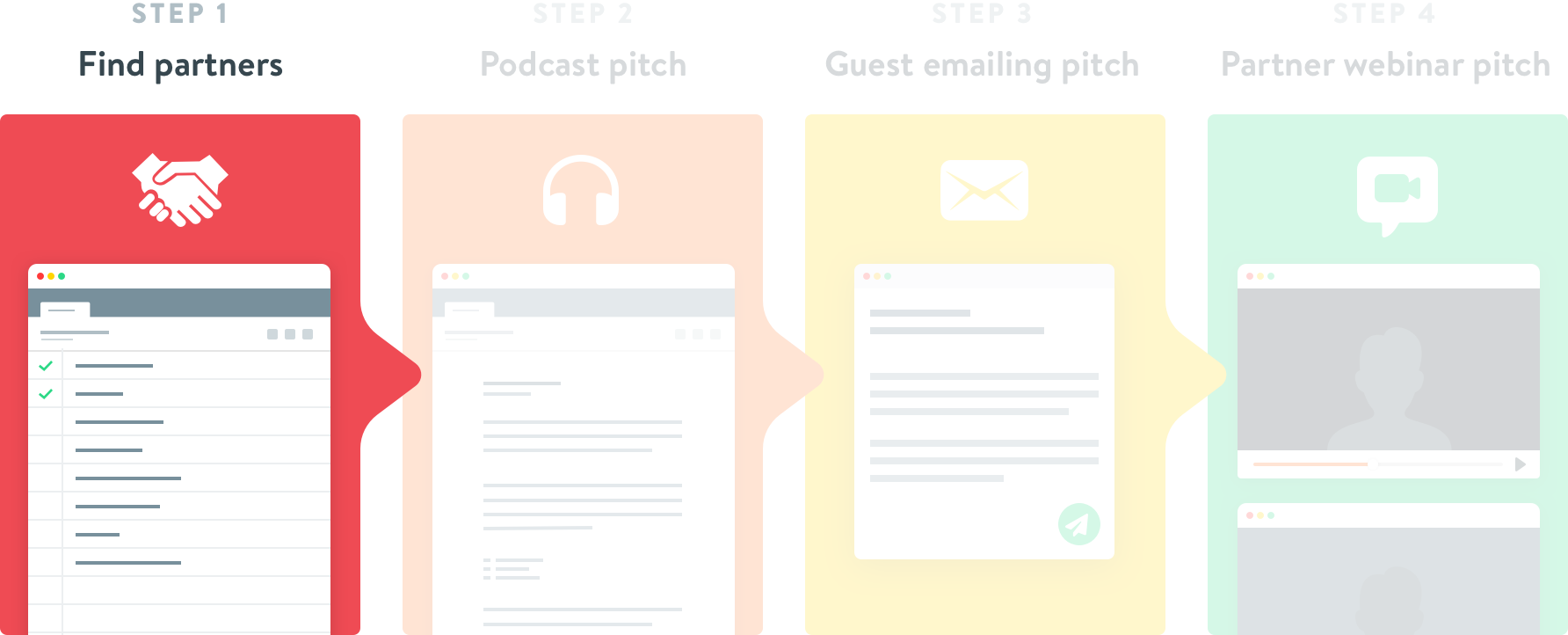
TL;DR: We created a special spreadsheet that helps you determine which potential partners you have the best chance of successfully pitching. To show you how it works, we fill it out for Sarah’s business and give you a free copy to use on your own.
So…how in the heck do you actually find people who will partner with you?
You make what we call a “Dream 50.”
Think of it like your own personal bucket list for partnerships—these are people and companies who, if you were able to partner with them, you could die happy.
Like any good bucket list, though, it’s going to have a mix of things that are totally doable (with some effort) and things that are lofty and unlikely.
Most importantly though, we built a special Dream 50 spreadsheet that will not only help you brainstorm and organize potential partners—it will also automatically score them based on how likely they are to partner with you:

But first, you have to actually fill it up with potential partners. 🙂
If you’re already feeling like you don’t know anyone who would possibly partner with your, don’t worry—I promise you do. You just need to know the right places to look.
15 Places to Find the Right Partners—Even If You’re Just Starting Out
Your Dream 50 will have two types of potential partners:
- Existing connections: people/companies you already know or have even a small connection to.
- Shoulder connections: people/companies who serve the same target audience you do, but in a different way.
To start, let’s talk about that first group—existing connections.
- Friends and family who have businesses: This could be anyone you know with a small business whose customers/audience might be interested in your niche.
- Blogs or email lists you’ve subscribed to (or that have featured/mentioned you): Look through your email inbox—any bloggers or entrepreneurs who might be open to a strategic partnership?
- Podcasts you listen to (or that have interviewed you): Open your podcast app and scroll through the shows you subscribe to. Do any have audiences that would be interested in your business/topic?
- Courses or digital products you’ve bought: Purchased any online courses/workshops/masterminds? You’ve already got an in with the person who sells it.
- Services you use: What software services do you use in your business? Being a customer is a great way to start a conversation with a potential partner.
- Books you’ve read: Authors often have an online platform and ways to connect with their audience.
- People you’ve interacted with online: Think about people you’ve talked to in Facebook groups, Slack channels, social media, or other online communities.
- People you’ve featured: Have you interviewed/talked/linked to anyone for a podcast, blog post, YouTube video, or other type of content you’ve published?
- Websites that have linked to your site: You can use an SEO tool like Ahrefs to see a list of every website that’s linking to yours.
- Your customers: Don’t forget about the people who like your business so much they’ve given you money for it. 🙂
Now, let’s talk about the second group—shoulder connections.
A shoulder connection is a person or company that serves the same target audience you do, but in a different way.
For someone like Sarah who teaches UX designers how to develop an awesome portfolio, a company like InVision that sells design software would be a shoulder connection. InVision’s customer base is FULL of people who could become new customers for Sarah, but she’s not competing with InVision for them. (Don’t try to partner with a direct competitor since you’d be fighting each other for the same dollars.)
To discover your own shoulder connections, ask yourself 5 questions about your core customer:
1: What podcasts do they listen to?
To figure this out for Sarah, we could simply search “design” or “UX” in any podcast app, or search “UX podcasts” on Google.
2. What popular blogs or websites do your customers visit?
If you can’t think of many, just google the name of your industry plus “blog.”
3. What conferences or virtual summits do your customers attend?
When you find conferences or virtual summits related to your industry, check out the speakers listed on their website. Many will be a shoulder connection for your business.
4. What LinkedIn and Facebook Groups do your customers hang out in?
Again, this is as simple as searching for your industry and shoulder industries in the groups section of Facebook and LinkedIn.
5. What other products or services do your customers use?
For Sarah, this will be any kind of design software (like the InVision example we mentioned earlier).
So…what should Sarah’s Dream 50 look like?
The key to putting a Dream 50 together quickly is to focus on a handful of categories you feel good about instead of trying to list potential partners in all of them.
After studying Sarah’s business, 5 specific categories jumped out that are full of great partnership opportunities for her:
- Shoulder products her customers use
- Podcasts that have interviewed her
- Speakers from industry conferences
- Blogs she’s subscribed to or written for
- Shoulder blogs her customers read
Just by focusing on these 5 categories, we were able to quickly list tons of potential marketing partners for Sarah:
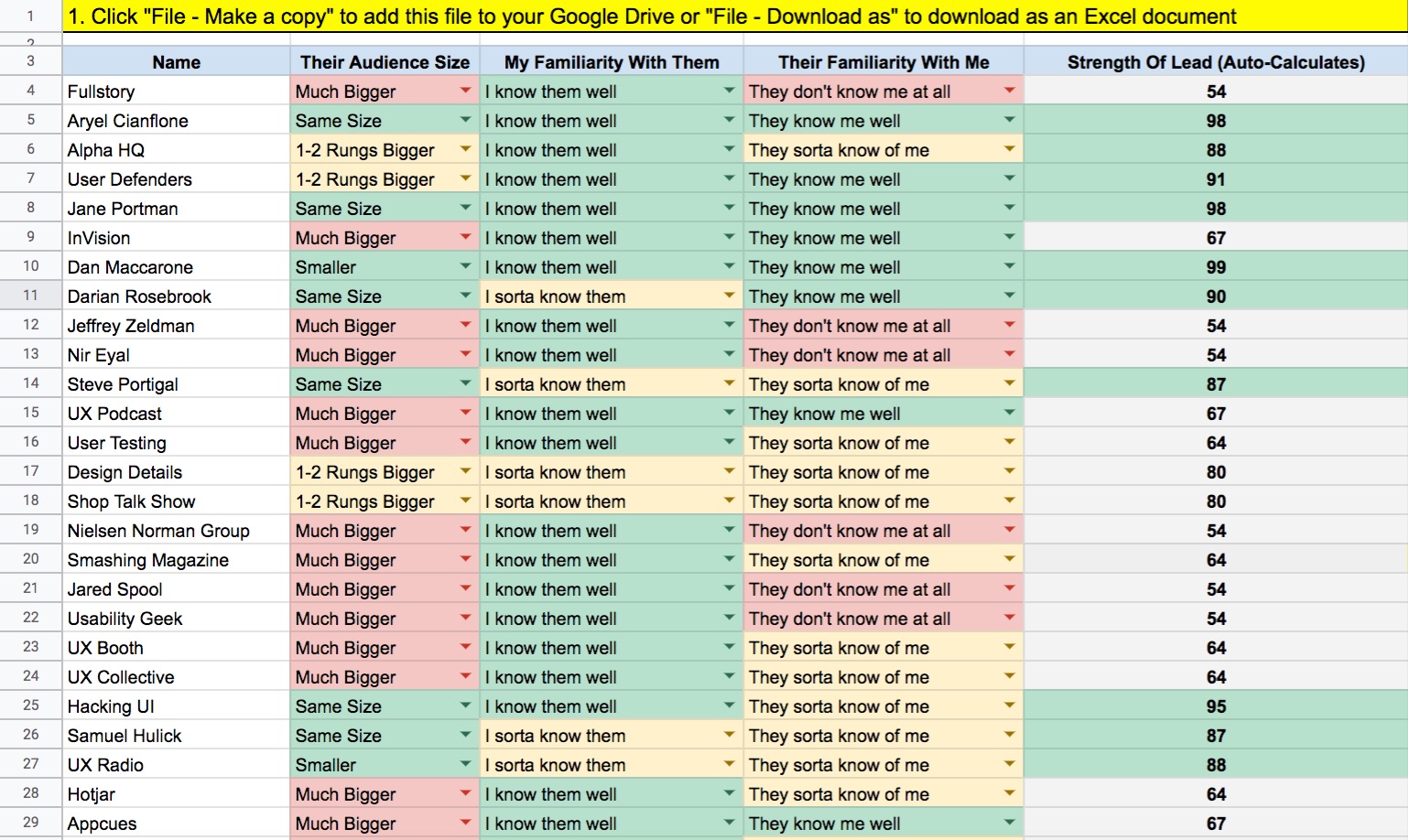
How do you decide which partners to pitch first?
Like I mentioned earlier, the coolest thing about our Dream 50 spreadsheet is that it has a built-in scoring formula that helps you figure out which people you have the best chances of partnering with.
For each potential partner on Sarah’s Dream 50, all we have to do is fill in a few additional details about their audience size and familiarity level.
For example, Fullstory is a software company that qualified as a shoulder product that Sarah’s customers used. When I click the “Audience Size” category, you’ll see I have 4 options:
- Much bigger
- 1-2 rungs bigger
- Same size
- Smaller

Think about audience size like rungs on a ladder. The top rung is someone with tens of millions of fans or customers, and the bottom rung is someone who is just getting started.
Some of your potential partners should be miles above you on the ladder, some should be just a couple rungs above you, some should be right around where you are right now, and some should be smaller than you (unless you’re just starting out).
Fullstory is a fairly large company, so I’m going to select “much bigger.”
The next category is “My familiarity with them.” There are 3 choices:
- I know them well
- I sorta know them
- I’ve never heard of them
My guess is that Sarah has used Fullstory for customer research, so I’ll select “I know them well.”
The last category is “Their familiarity with me.” The 3 options here are:
- They know me well
- They sorta know of me
- They don’t know me at all

I’m going to say “They don’t know me at all” here since I didn’t find any existing public connection between Fullstory and Sarah online.
The spreadsheet gives her a “Strength of Lead” score of 54 for Fullstory, which means it’s not impossible, but definitely not a slam dunk. It’s not exactly a “low hanging fruit” lead, but if she feels strongly about pursuing it, she should give it a shot.

Once you’ve filled out your own Dream 50, your scores will help you figure out which partners present the easiest opportunities, so you know which ones to pursue first.
Reminder: You can get a free copy of our Dream 50 spreadsheet when you grab the bundle of partnership resources we created for this post.
Step 2: Pitching Your First Partnership
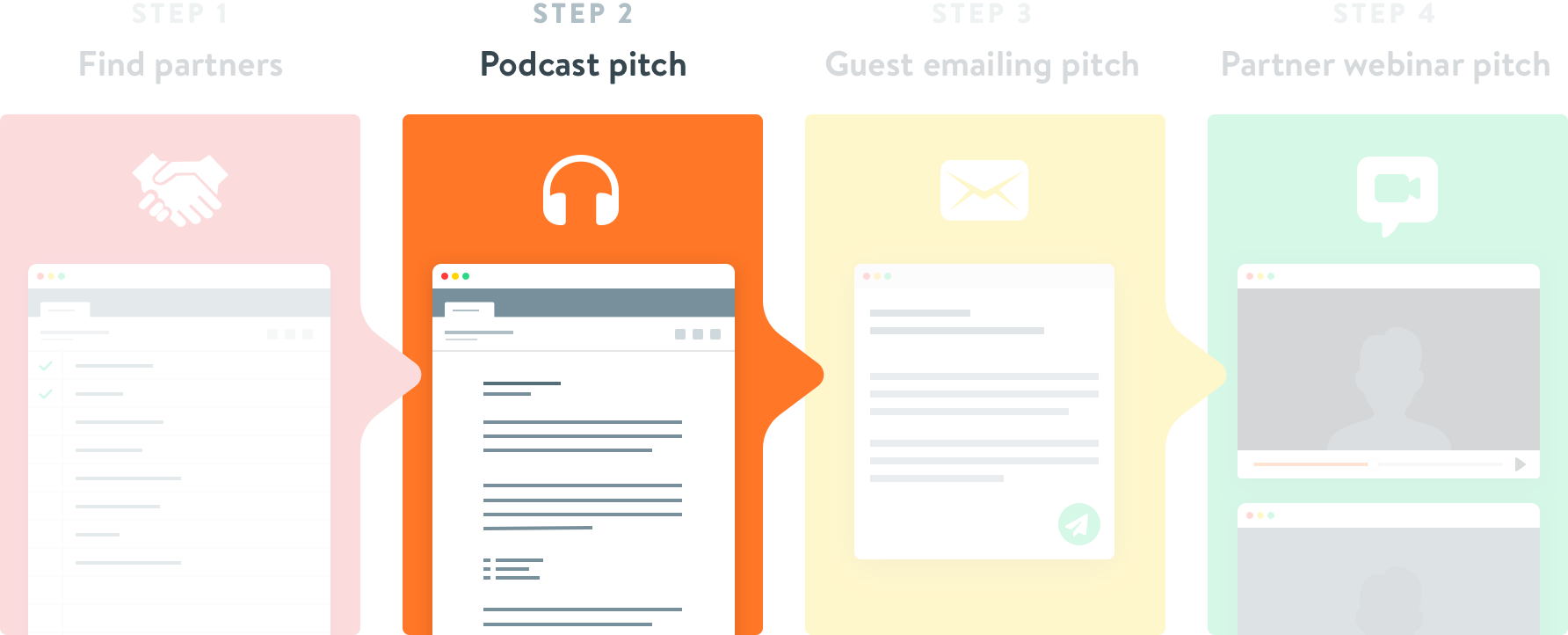
TL;DR: By pitching businesses on something simple (like a podcast interview), you can open the door to bigger and better partnerships down the road while also generating leads in the present. You’ll see the pitch emails Sarah could write to 3 potential partners: one that she doesn’t know at all, one that she has a loose connection to, and one that she knows well. Then you’ll see how to execute the interview to maximize lead generation.
After discovering your best initial pitch targets, the next step is to figure out what type of partnership you want to pitch to them.
My advice? Unless you already have a strong relationship with them, start with something small that you’ve seen them do with other people, like a podcast interview or a guest blog post. After building the partner relationship with a small project, you can then “stair step” your way to bigger and better marketing methods, like webinars.
In Sarah’s case, I’m going to show you how she could pitch 3 potential partners on interviewing her on their podcast. After that, I’ll show you how she could “stair step” up to a Guest Emailing partnership and a Partner Webinar (you’ll see those in steps 3 and 4).
Your pitch will change a little bit depending on how well you know the person you’re pitching. With that in mind, I picked 3 potential partners from the Dream 50 we made for Sarah that have 3 different levels of familiarity with her:
- Smashing Magazine — doesn’t know Sarah at all
- Steve Portigal — has a loose connection to Sarah
- InVision — has an existing relationship with Sarah
So whether you’re just getting started and don’t have many relationships or you’re an established business with existing connections, you’ll see a pitch example that applies to you.
How to Write a Partnership Pitch
Every partnership pitch (no matter what type of partnership you’re pitching) must have 3 ingredients to be successful:
- A relational anchor: This explains your connection to the partner so they can see you’re not a random weirdo (even if the connection is just that you’re a fan of their work).
- A win for the partner: This explains why the partnership will benefit them.
- A clear ask: Your partner should be able to respond with a simple “Yes, I’m interested,” or “No thanks.”
The easiest way to learn what these parts look like is to see them in action.
So let’s take a look at the first podcast interview pitch I wrote for Sarah. It’s written to the host of Smashing Magazine’s podcast, and is a prime example of how to pitch someone who doesn’t know who you are:
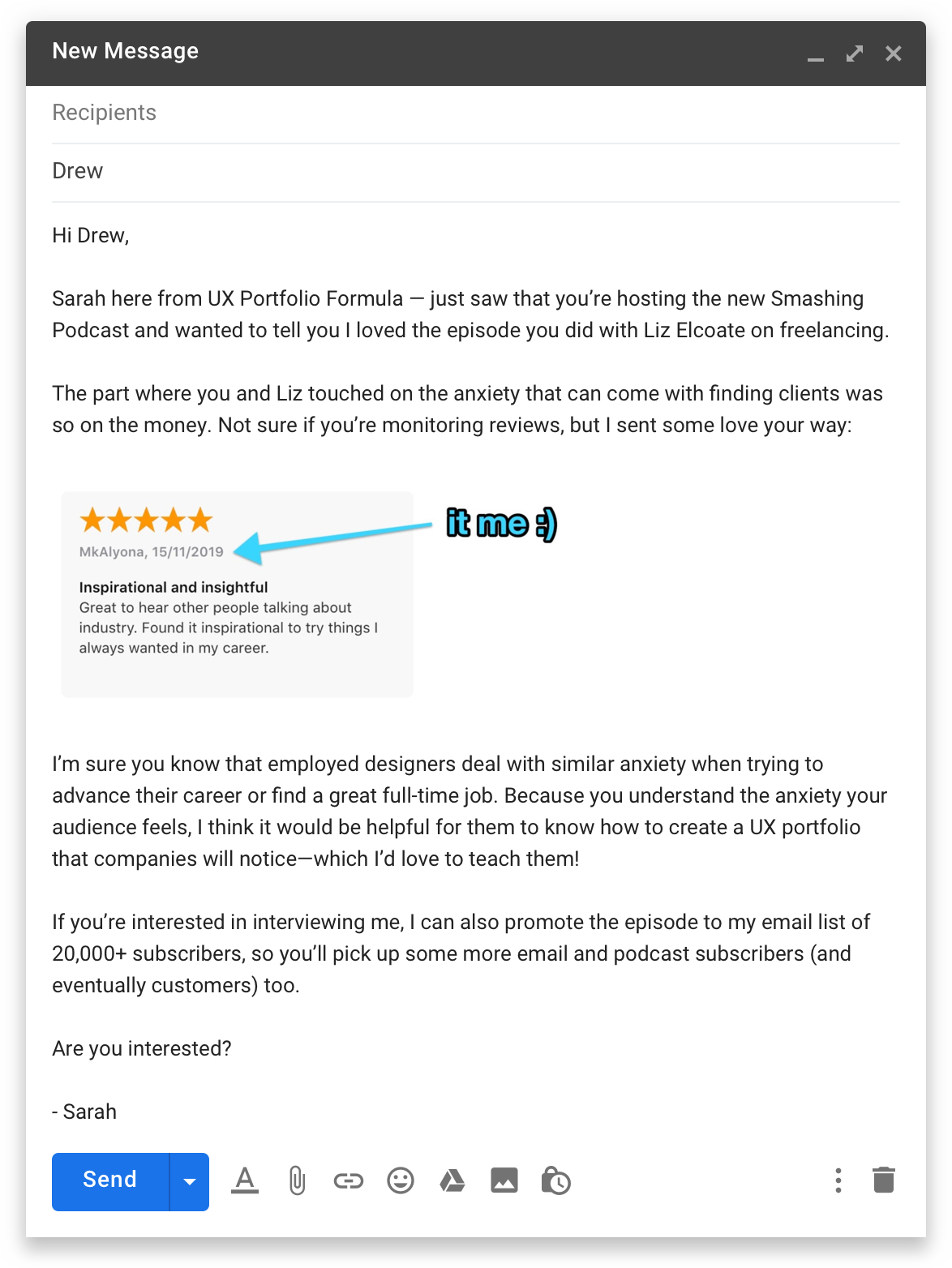
Alright, let’s break down how this email incorporated the 3 essential ingredients of a rock-solid partnership pitch:
Ingredient #1: Relational Anchors
Even though Sarah has never met Drew and doesn’t have a relationship with Smashing Magazine, there are still 3 relational anchors packed into the first 3 sentences:
- Anchor #1: She compliments him on the new podcast.
- Anchor #2: She lets him know she left a review in a fun, casual way.
- Anchor #3: She mentions something she liked about a specific episode, which proves she’s an actual listener.
The combination of these 3 anchors immediately qualify Sarah as someone who has a genuine interest in the podcast and isn’t just spamming every UX podcast she can find with the same generic pitch.
Note: When I say “genuine interest” I mean it. If you can’t find a genuine reason to be interested in a potential partner, then move onto someone else. Don’t fake admiration or simply say you liked their most recent episode to trick someone into becoming a partner brand. Take the time to study them and find something that actually resonates with you.
There are 2 types of anchors you can use if you’re emailing a potential partner who has probably never heard of you:
1. Consumption Anchors:
- Tell them you read a blog post, listened to a podcast, watched a webinar, etc.
- Tell them you bought their product
- Describe specific benefits/results you’ve gotten from their content or product
2. Promotion Anchors:
- Tell them you shared their content
- Tell them you shared their product
Whichever anchors you use, the most important thing is to be genuine. Don’t just grab a random blog post they wrote, share it on social media, and then email them saying you’re their biggest fan.
Ingredient #2: Win for the Partner
This is where it’s easy to get stuck with a pitch, especially if you’re just starting out.
“But I don’t have a huge audience to offer the partner in return! What win can I offer them??”
Listen up: EVERYONE you pitch is going to have the same need—valuable content to offer their audience. Content marketing—be it podcasts or blogs or social media—takes lots of (you know where this is going) content to keep going.
All you need to do in your pitch is demonstrate that:
- You recognize a specific problem/challenge their audience has, and
- You have the expertise to help them solve that problem/challenge
Boom. You’ve just handed them their next content idea, for free. That’s exactly what we did in this part of the pitch:
“I’m sure you know that employed designers deal with similar anxiety when trying to advance their career or find a great full-time job. Because you understand the anxiety your audience feels, I think it would be helpful for them to know how to create a UX portfolio that companies will notice—which I’d love to teach them!
“If you’re interested in interviewing me, I can also promote the episode to my email list of 20,000+ subscribers, so you’ll pick up some more email and podcast subscribers (and eventually customers) too.”
And look, I know it also includes a promise to promote the podcast to Sarah’s large email list, and you may not be able to make a similar promise.
But even if all you can offer is valuable content for the partner’s audience, your email will still be stronger than 99% of the pitches your partner receives.
Of course, if you DO have an existing audience, you’d be crazy not to mention it (whether it’s an email list, Instagram following, Facebook group, YouTube channel, etc.). Which is why I included the mention of Sarah’s email list.
This part of the pitch makes it clear there’s a win-win: They get your help engaging their followers and you get access to a new audience.
Ingredient #3: Clear Ask
“Are you interested in collaborating together on something?” is not a clear ask.
“Are you interested in having me on your podcast to teach your audience how to build a UX portfolio that will get them hired?” is a very clear ask.
All it takes is a simple yes or no from the partner to advance the conversation.
Pro Tip: When your pitch makes it easy to respond, you will get more responses. It’s that simple.
When writing your own, I suggest starting by putting “Are you interested?” at the bottom. That way, you’ll force yourself to build up to a clear ask from the start.
What Would This Pitch Look Like for More Familiar Partners?
No matter how well you know a potential partner, your pitch should still always include an anchor, a win for the partner, and a clear ask.
As a general rule, though, the stronger your connection the fewer anchors you need at the beginning.
For example, let’s take a look at the other two hypothetical podcast pitch emails I wrote for Sarah.
Podcast Interview Pitch #2: Pitching Someone You Sort of Know
This one is for Steve Portigal, a user research consultant who hosts a podcast called Dollars to Donuts and wrote a book called Doorbells, Danger, and Dead Batteries: User Research War Stories.
While I don’t know if Sarah and Steve know each other, I do know that they both spoke at the Productized Conference in Lisbon this year—which makes for a strong, simple anchor. Let’s check it out:
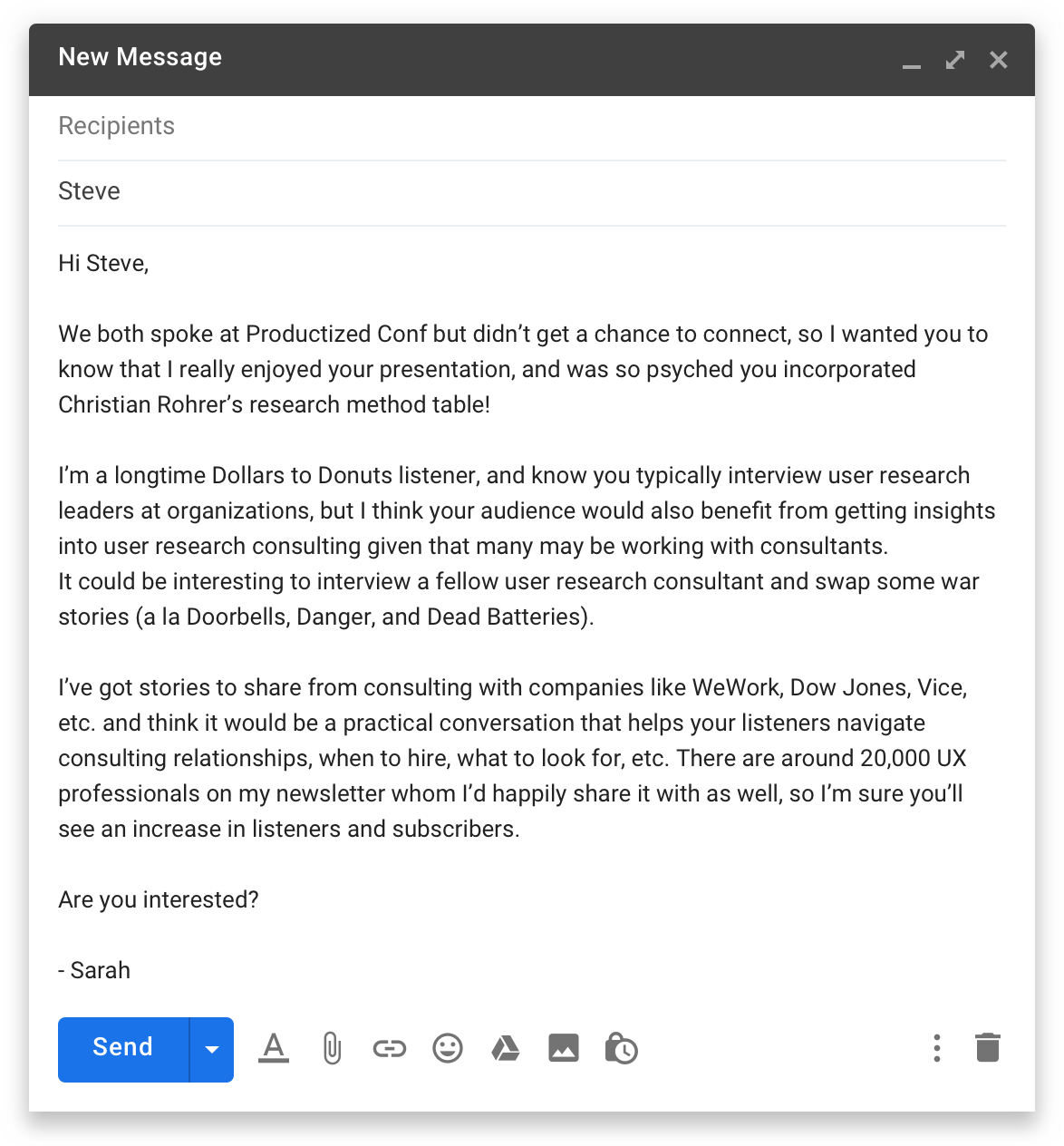
As you can see, since the anchor in this email provides instant social proof, there doesn’t need to be much more of an introduction before getting to the ask.
Still, the ask demonstrates that Sarah has followed Steve for a while and understands his content and audience. She’s done enough homework to at least get a response back, even if the answer is ultimately no.
Podcast Interview Pitch #3: Pitching Someone You Know Well
If you have a strong existing relationship with someone, the most important thing is to not overthink your pitch.
You don’t need to shoehorn some kind of awkward relational anchor to remind them you know each other—just be clear about what you’re asking and how you think it would be beneficial to them.
For example, Sarah has been publishing a series of guest articles for InVision’s blog for over a year now, but she’s never been featured on their popular podcast, Design Better.
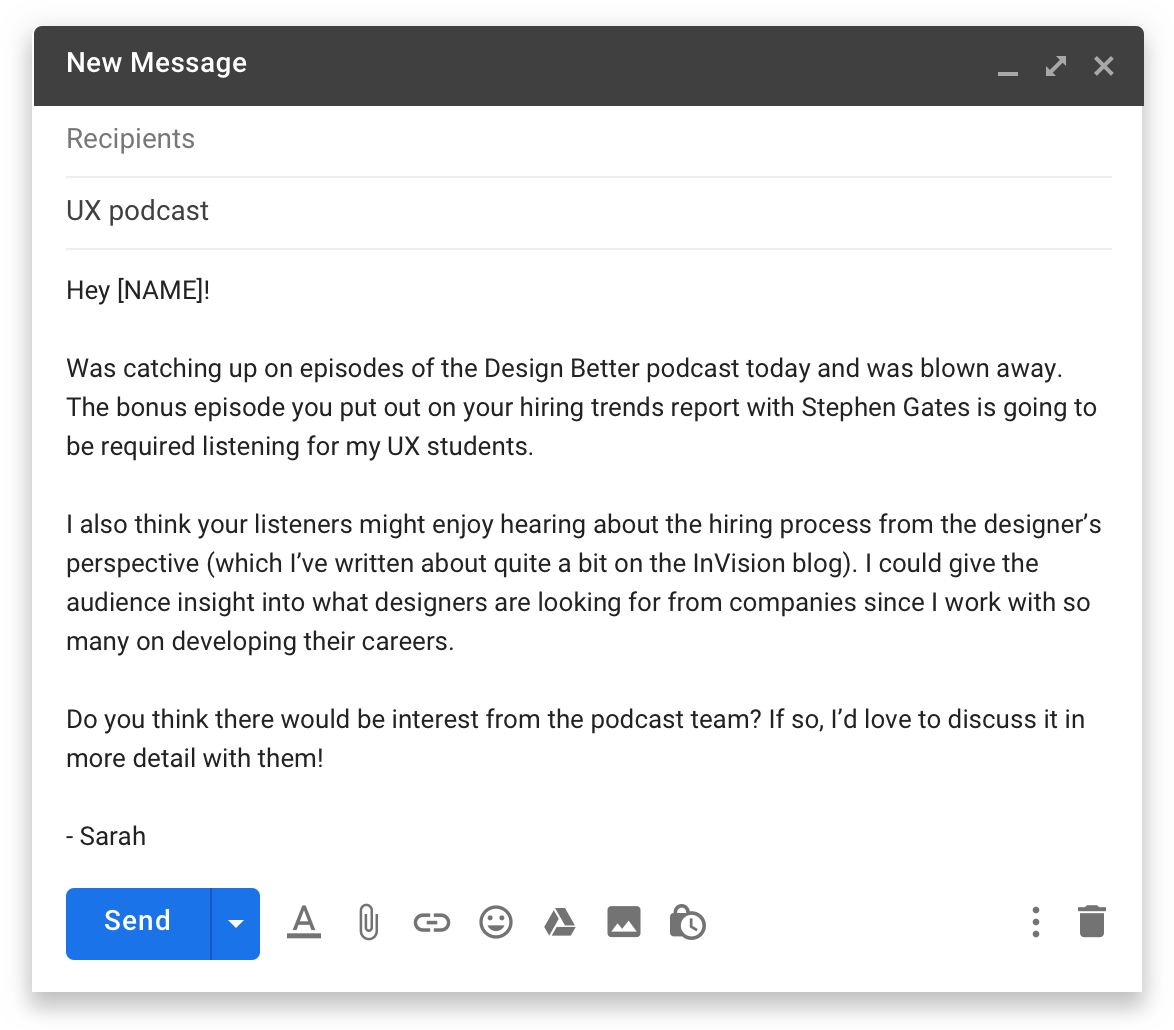
Casual, low-pressure, direct, and best of all—easy for the recipient to respond to!
That’s how you pitch someone you know without it feeling like a “pitch.”
How to Execute This Partnership:
Even though a podcast interview is often a “Step 1” partnership, that doesn’t mean it can’t be extremely valuable for your business.
If you execute it properly, you can turn one podcast interview into an evergreen source of high-quality leads that sends you customers for years to come.
To make the most of a podcast interview, you need to do 3 things (other than provide great, relevant content during the interview, of course):
1. Create a lead magnet specifically for listeners of the episode.
This marketing technique will get you way more leads than what most marketers and entrepreneurs get from a podcast interview.
When someone gets interviewed on a podcast, there usually ends up being a generic call to action to check out their website or follow them on social media at some point during the episode.
While this is a decent way to generate leads, you can get WAY better results if you take a tiny bit of extra time to make a unique free resource that’s exclusive for people who listen to the episode.
For example, let’s say Smashing Magazine says yes to Sarah’s pitch to be on their podcast. Since she’s going to talk about building an awesome UX portfolio on the show, she could create a simple checklist that walks listeners through the tips she offers during the interview, like this:

Sarah could then create a simple opt-in page at a URL like sarahdoody.com/smashingpodcast where listeners can sign up to get the free checklist.
2. Mention the lead magnet during the first half of the interview.
If you wait until the end of the interview to mention your lead magnet, the vast majority of listeners will never hear it.
Since you’re going out of your way to create something valuable specifically for listeners of the podcast, this generally doesn’t come off as overly self-promotey.
(Especially if you let the host know you created it in advance. Which is as simple as emailing them, “Hey, I made this cool resource to give away to listeners. Is it cool if I mention it during the interview?”)
3. Ask the host to include a link to your lead magnet on the episode page.
Usually, the episode page will feature a link to the interviewee’s website. If the interview goes well and you feel good about the relationship, consider asking the host to link to the landing page you made for the lead magnet rather than (or in addition to) your homepage.
This works best (and saves the host some time) if you provide the copy. For example, here’s what Sarah could ask Smashing Podcast to feature on her episode page:
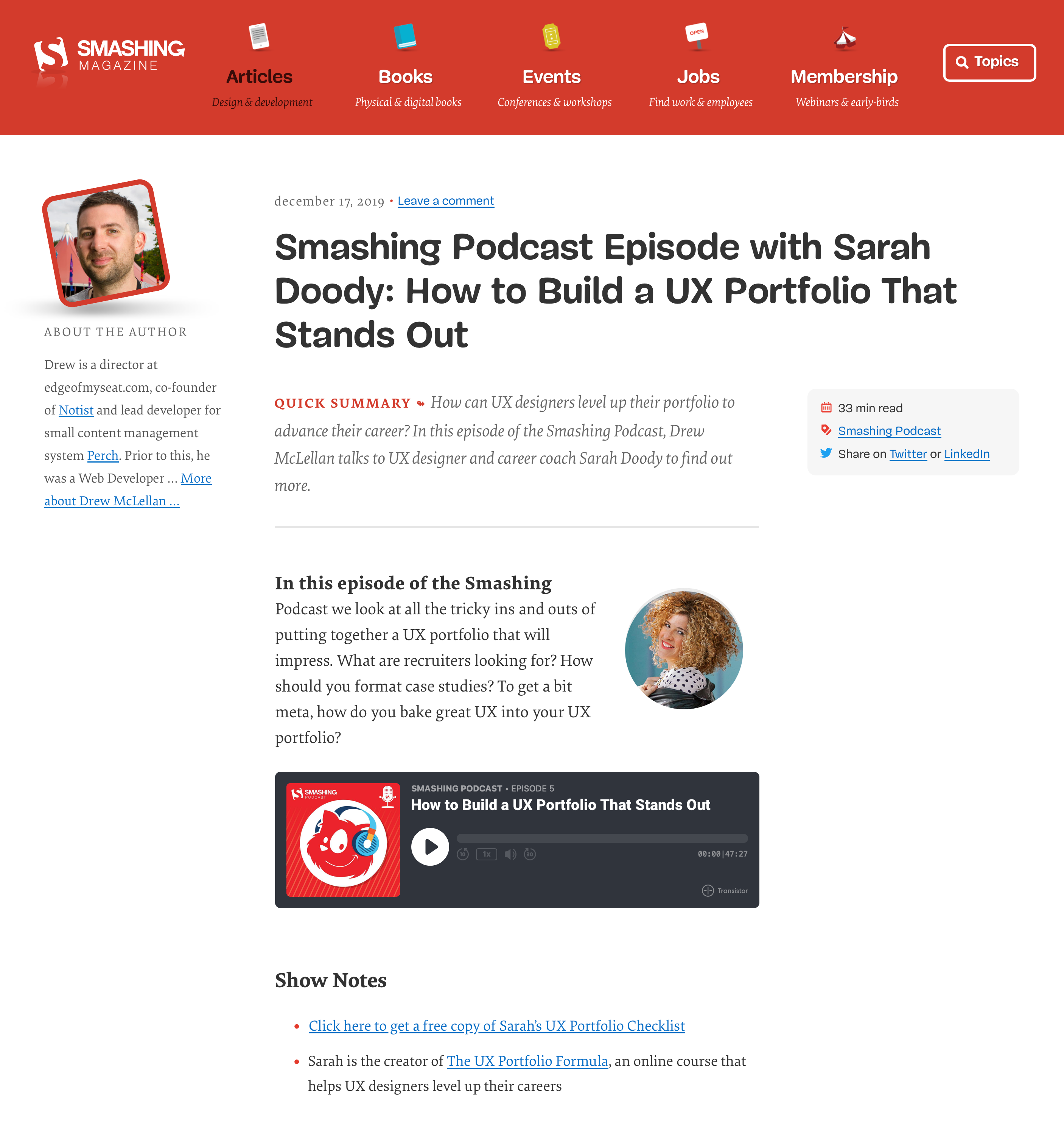
It’s easy to imagine how much more effective that would be than the typical “Check out her website here” CTA, right?
Expected Results for a Podcast Interview Partnership:
The leads you’ll generate from a podcast interview obviously vary depending on the podcast’s audience size, but here’s the cool thing—since podcasts are evergreen, one episode can continue generating potential customers for you for months (and even years) to come.
Your key metric should be leads generated. As a general rule, you can expect 5-10% of the people who listen to a podcast episode to sign up for your list if you offer a lead magnet. (Without the magnet, you’ll get “brand awareness” and a handful of leads.)
If 1,000 people listen to it, you could expect 50-100 subscribers.
For 5,000, you could expect 250-500 subscribers.
For 10,000, you could expect 500-1,000 subscribers.
Step 3: Stair Step to a Guest Emailing Partnership
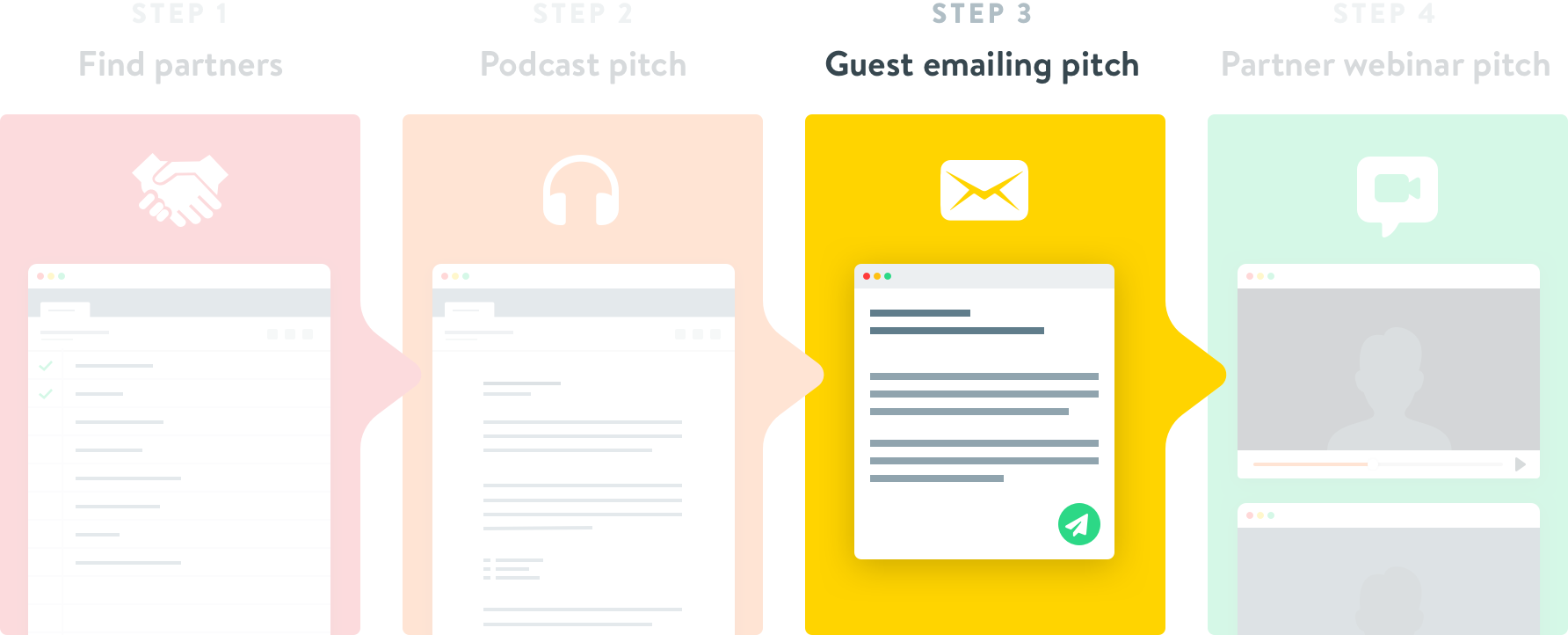
TL;DR: Guest Emailing is similar to Guest Blogging, but requires a fraction of the effort and produces 10x the results. In this step, I’ll show you how to pitch partners on Guest Emailing by writing an example pitch for Sarah’s business. You’ll also get email templates to help you generate the most leads for your business when you execute the partnership.
Guest Emailing is an incredibly simple partnership marketing strategy that very few businesses take advantage of currently.
Here’s the basic gist:
You ask a potential partner to email your lead magnet as a free gift to their audience. In exchange, you offer to email one of their lead magnets to your audience.
It’s a lot like Guest Blogging, but requires a fraction of the work (because you don’t have to create an entire blog post from scratch) and produces 10x the results.
For example, when we teamed up on a Guest Emailing partnership with Infusionsoft (a fairly large email service provider in our space) we gained 2,200 new subscribers in the first week.
When Alp Turan, a coaching client of ours who runs a marketing blog, did a Guest Emailing partnership with a software startup in his space, he added 312 new subscribers to his list in less than 48 hours.
Since it’s a slightly more complicated marketing activity than something most companies are already doing (like podcast interviews and guest posts), we typically recommend it as a “Step 2” partnership.
However, if you feel good about it, you can absolutely skip right to Guest Emailing as your first pitch to a partner. I’ve seen plenty of students in our Partnership Accelerator class pull it off as their first partnership ever.
How to Write a Guest Emailing Pitch
The key thing to remember when writing a guest emailing pitch is to start by looking at the content they have that you could promote to your list.
First, you need to find some type of lead magnet they’re offering that
- You genuinely like, and
- Your audience would be interested in
When you reach out to the partner, you’ll lead by offering to send their lead magnet to your email list.
For example, here is how Sarah could pitch Smashing Magazine on a Guest Emailing partnership after appearing on their podcast:
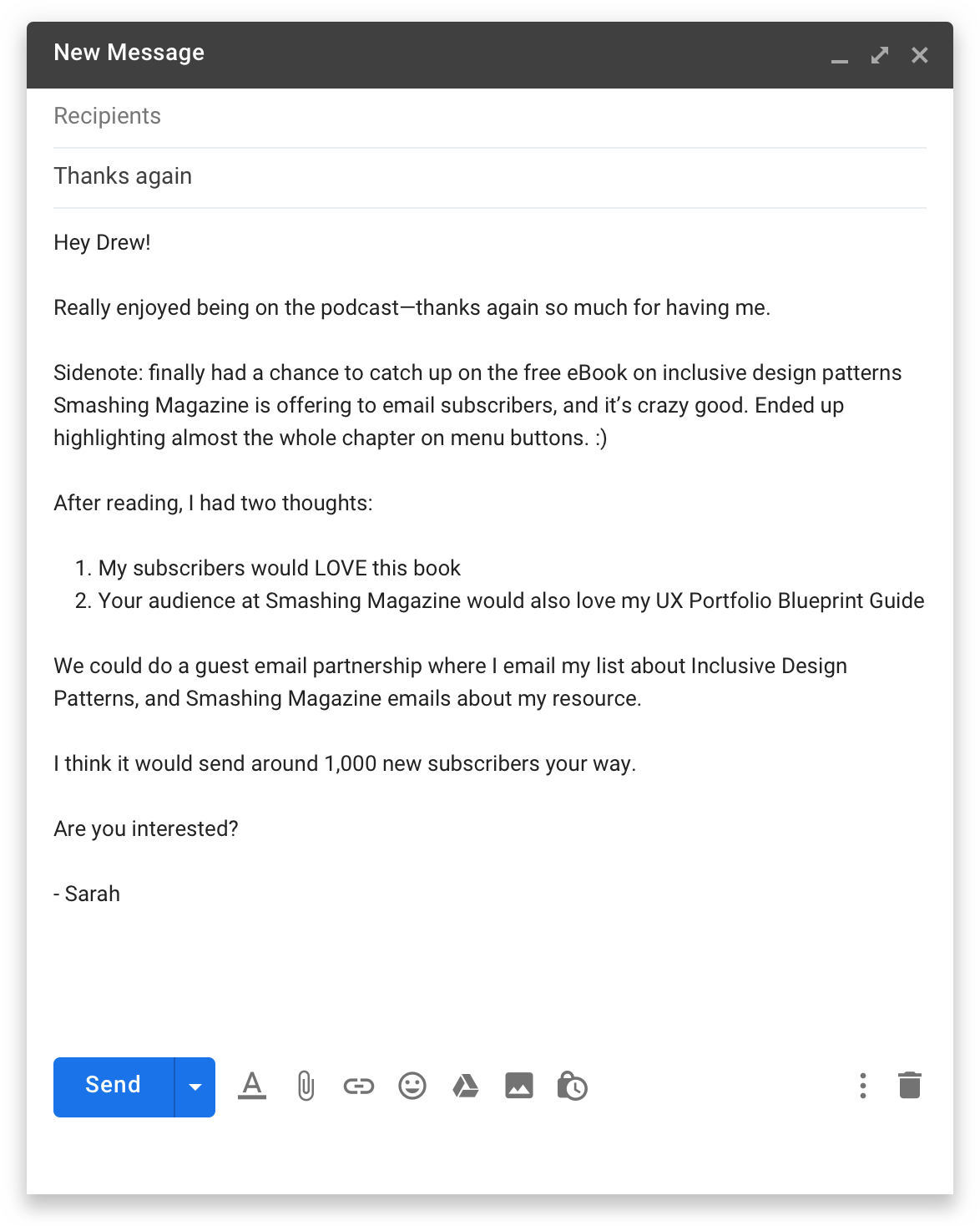
Now, since Smashing Magazine isn’t just a company of one, the person who hosts their podcast might not be the decision maker on something like this. However, he could definitely give Sarah a warm introduction to the right person.
2 Important Things When You Write Your Own Guest Emailing Pitch:
Thing #1: Your relational anchor will be different if this is the first partnership you pitch someone.
Obviously, if you didn’t just appear on someone’s podcast, you shouldn’t use an anchor like, “Really enjoyed being on your podcast—thanks again for having me.” 🙂
So if this is the first pitch you’re sending someone, approach the anchor the same way I did in the podcast interview pitches in the previous section.
If it’s someone who doesn’t know you, simply use a consumption or promotion anchor.
Thing #2: Even if you have a small email list, you can still do Guest Emailing partnerships.
But you may have to aim for partners who have around the same size audience as you or, at most, 1-2 rungs larger.
For example, even if you only have 100 email subscribers, if you got someone with the same sized list to do a Guest Emailing partnership, you could still add 10-20 new subscribers—which makes a big difference early on!
How to Execute This Partnership:
Once a partner agrees, you’ll need to do 2 things to execute the partnership:
- Write an email for your list that promotes the partner’s lead magnet
- Write an email your partner can send their list to promote your lead magnet (and give it to them)
Giving your partner an email draft they can use to promote your lead magnet will not only save them time, it’ll also increase the odds they send an effective email.
But first, let’s look at the email you’ll write to promote your partner’s lead magnet.
Email #1: The Email You Send About Your Partner
The structure I recommend for this email is simple and straightforward. No need to tell your partner’s life story—just position their lead magnet as a cool resource you recently found and want to share.
For example, let’s say Smashing Magazine agrees to Sarah’s Guest Emailing pitch. Here is how I would write the first email if I were her:
SUBJECT: Every UX pro should have this book
Happy Monday!
Quick share today…
A couple years back my friends at Smashing Magazine published an entire book on inclusive design patterns and how to build accessibility into everything you design—which is a pretty crucial skill for any UX professional.
They recently made the whole book available free in PDF format, so I wanted to make sure you grab a copy to add to your design toolbox.
All you have to do is click the link below and Smashing Magazine will send a copy right to your inbox (you’ll also get a weekly email full of great design content from them).
Get your free copy of Inclusive Design Patterns.
Hope you find it as valuable as I have!
– Sarah
I know that might seem basic, but we’ve found keeping the email short and sweet leads to more clicks and subscribers.
Email #2: The Email Your Partner Sends About You
This email will follow the same structure as Email #1. For example, here’s what Sarah could write for Smashing Magazine to send out about her lead magnet:
SUBJECT: Level up your UX portfolio
We recently had UX career coach Sarah Doody on the Smashing Podcast to tell us how UX designers can advance their careers with a standout portfolio.
But did you know Sarah has an entire free collection of templates and checklists that make leveling up your portfolio even easier?
It’s called the UX Portfolio Blueprint and it’ll show you exactly how to choose the right projects for your portfolio, what to write for each case study, and how to structure everything visually.
It’s an essential tool for any UX professional, so click below grab a free copy (you’ll also get Sarah’s weekly UX newsletter).
Get your copy of the UX Portfolio Blueprint.
Enjoy!
One important note about the link to your lead magnet:
This strategy is much more effective if you use a one-click opt-in tool instead of linking to an opt-in page for your lead magnet.
With a one-click opt-in tool, people will automatically be added to your list as soon as they click the link to your lead magnet. This will get you a much higher conversion rate than using a landing page.
We built a free tool called One Click that lets you set up this kind of link super fast, and I recommend you use it for any Guest Emailing partnership (as long as you check with your partner and make sure they’re cool with it).
Expected Results for a Guest Emailing Partnership:
You can generally expect around 5-10% of the people your partner emails to become subscribers on your list (that percentage declines as their list size increases). For example:
- If your partner emails 100 subscribers about your lead magnet, you could expect to add 10-20 subscribers (although with lists this small it can often be much higher).
- If your partner emails 1,000 subscribers about your lead magnet, you could expect to add 80-90 new subscribers.
- If your partner emails 10,000 subscribers about your lead magnet, you could expect to add 500-600 new subscribers.
Step 4: Stair Step to a Partner Webinar
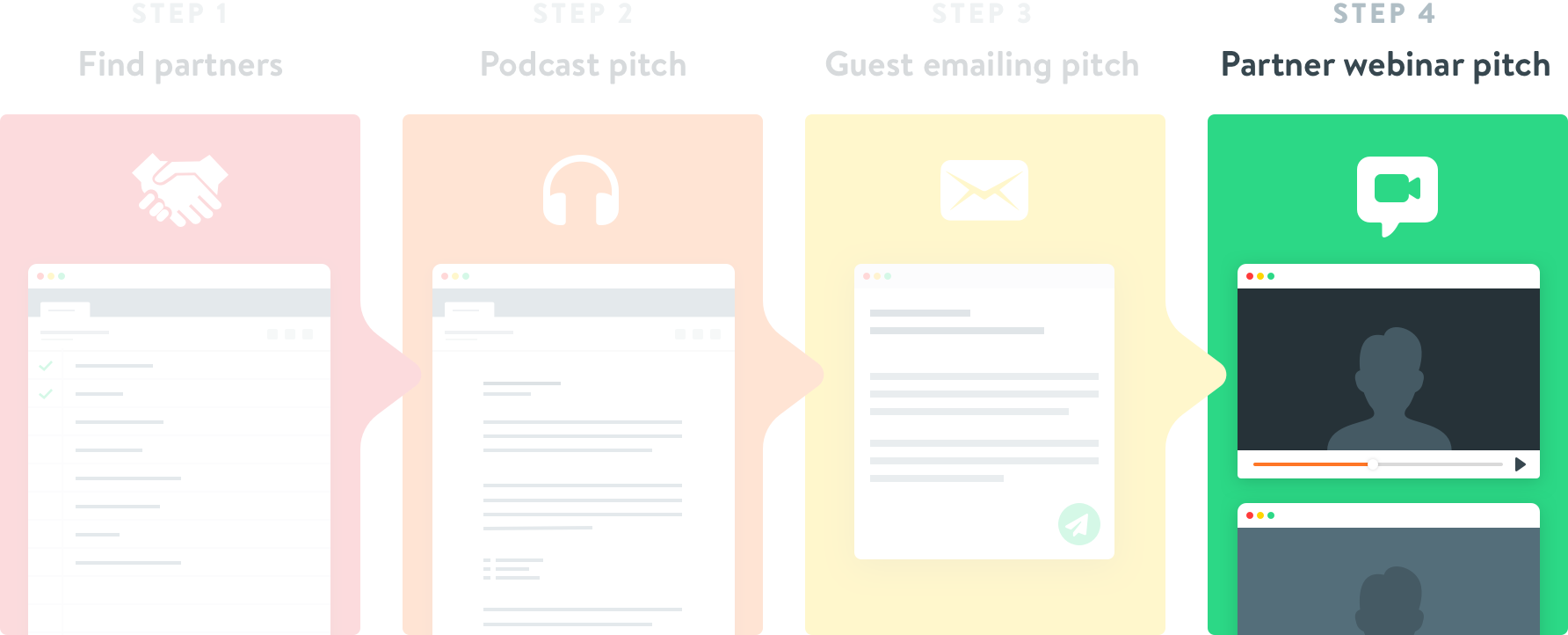
TL;DR: Whether you have something to sell or not, partner webinars are one of the fastest ways to add hundreds of subscribers to your email list in one fell swoop. In this step, I’ll show you how to pitch partners on hosting a partner webinar with you by writing an example pitch for Sarah’s business.
Partner webinars are generally thought of as a sales tool, but whether you have something to sell or not, they can be one of the most effective ways to rapidly build an audience and grow your email list.
For example, in the earlier days of Growth Tools I once spent 6 months focusing exclusively on doing partner webinars in which I didn’t pitch a product at all. I would spend 45-60 minutes teaching someone else’s audience something valuable about email list-building.
At the beginning, we had 10,000 subscribers on our list. Six months and 22 partner webinars later, we had 25,000 subscribers, for an average of 681 subscribers per webinar.
The best part? The content was 90% the same for each webinar. All I had to do was tweak and adapt it to fit each partner’s audience.
So whether you have something to sell during your webinars or not, you can use the same approach.
How to Write a Partner Webinar Pitch
The key thing to remember when writing a partner webinar pitch is to look at what types of live online training your partner currently offers or has offered in the past.
If you can tailor your pitch to a type of live training they are used to doing, your odds of success will increase.
For example, when Marissa Meddin (a coaching client of ours) was looking for webinar partners, she found a website called Road2College that served the same audience as her (parents who are helping their children get into college).
While Road2College didn’t regularly host anything they called “webinars,” they did regularly host Facebook Lives for their Facebook community of 40,000+ members. So that’s what Marissa pitched them on when she reached out.
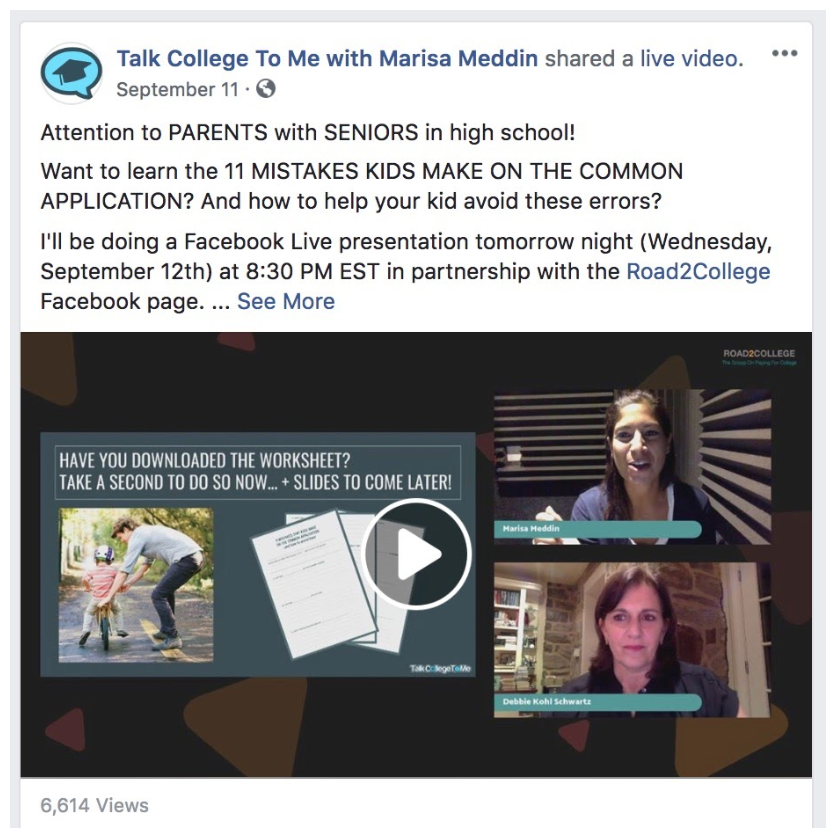
(By the way, that partner Facebook Live training resulted in 275 new subscribers for Marissa and 33 sales of her $97 course.)
If Sarah wanted to stair step from a Guest Emailing partnership to a partner webinar with Smashing Magazine, she could easily find out they offer a monthly webinar for their premium membership community by taking a couple minutes to browse their website:
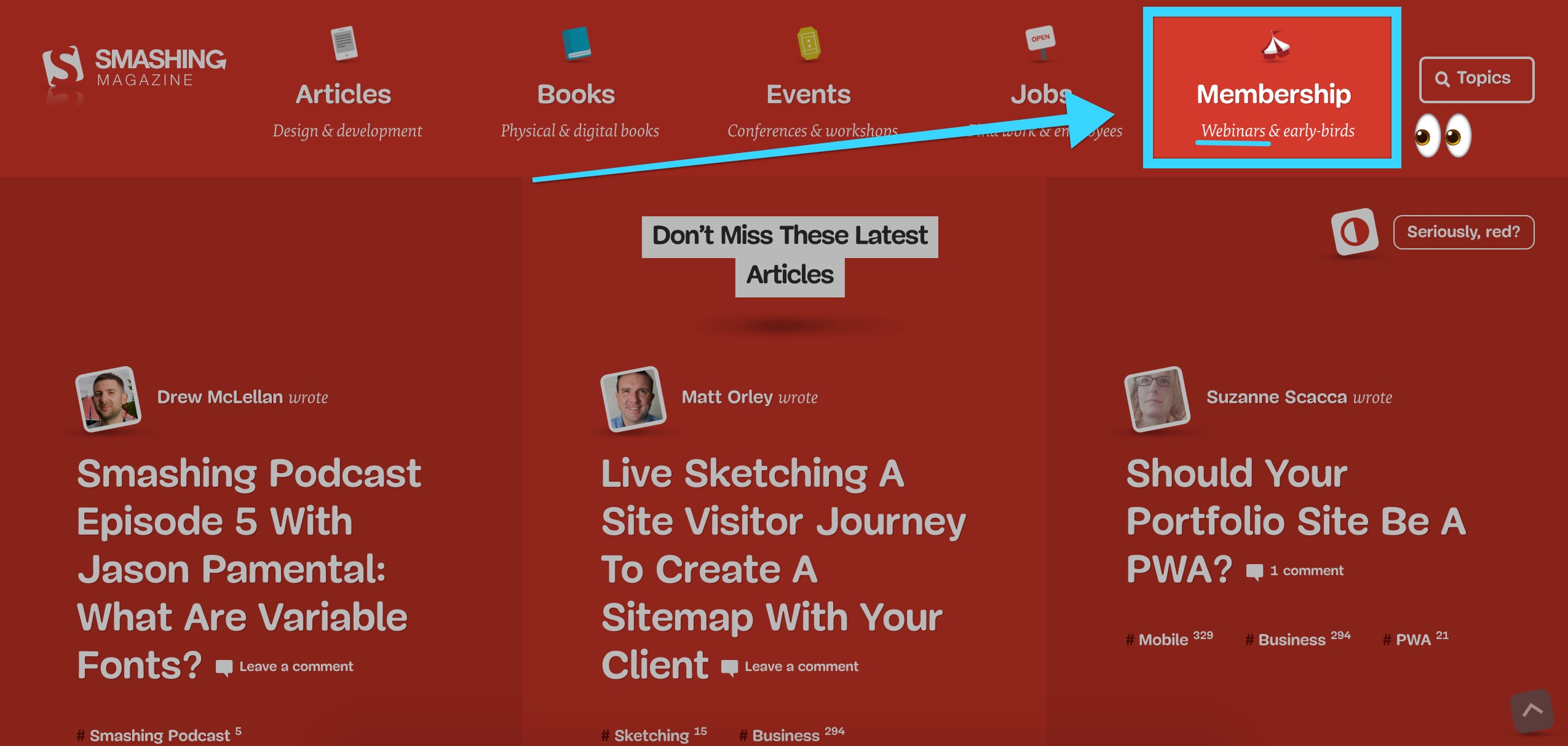
Even better, the people who choose a paid pricing plan for Smashing Magazine have already invested in their UX careers… making them ideal leads for Sarah.
Here’s how I would write the pitch:
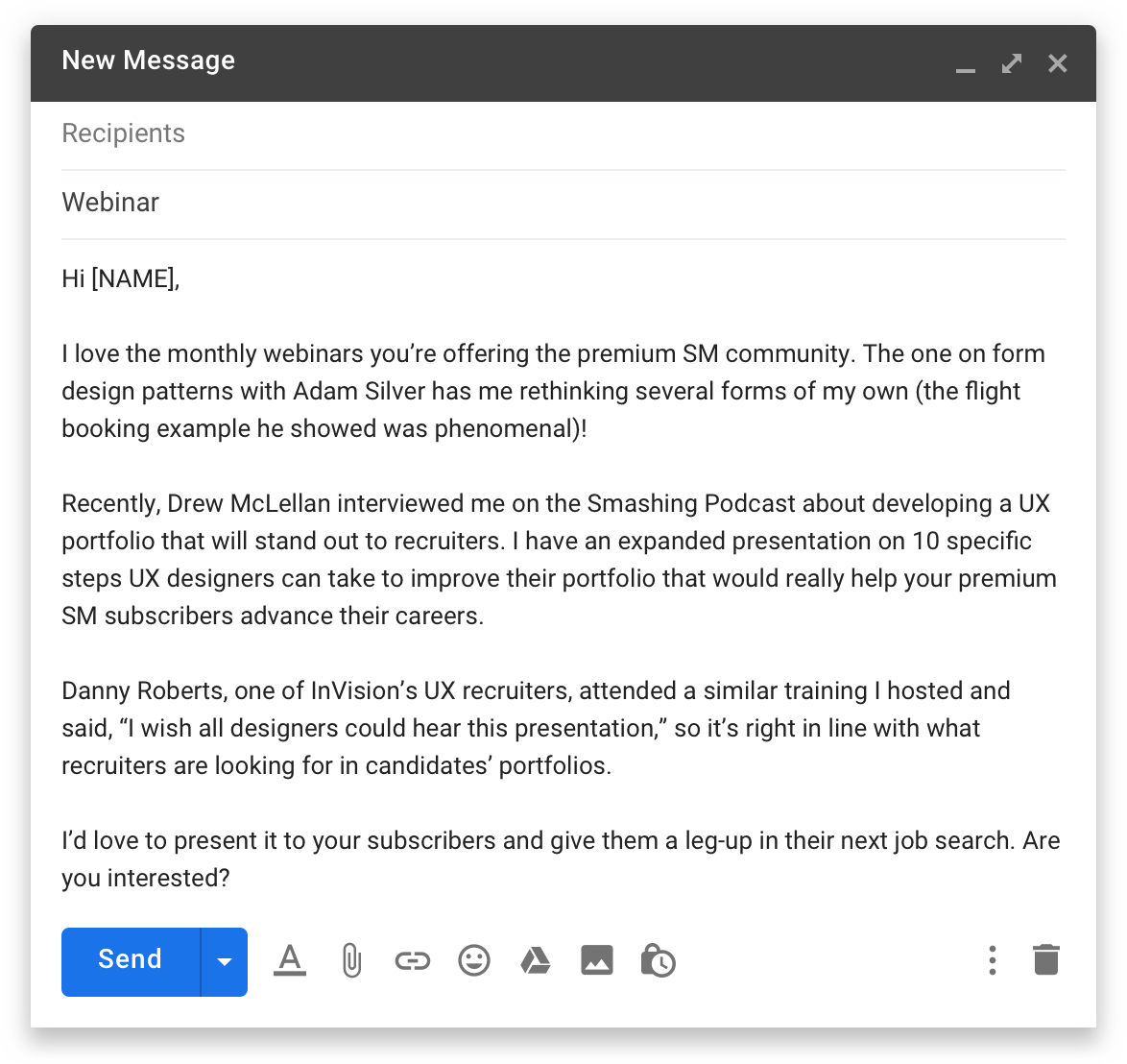
Note: If the partner you want to pitch a webinar to doesn’t currently host any type of live online trainings, don’t let that hold you back! As long as your pitch communicates why it would be valuable for their audience—and that you can handle setting up the tech to run the presentation—you can still get a yes.
How to Execute This Partnership:
Building an effective webinar presentation is a topic for its own entire blog post (which I wrote about here), so for now I want to focus on 2 specific things that will help you generate the most leads possible from a partner webinar.
The approach you take will depend on if you are hosting the webinar or your partner is.
If you are hosting the webinar:
Instead of giving your partner a webinar registration page to send their audience to, give them a one-click registration link.
Just by doing this, you can increase the number of registrations by at least 40%.
Why? Because a one-click registration link instantly registers someone for your webinar right from the email your partner sends. Instead of forcing them to click, wait for a registration page to load, and enter their email address again, they can register instantly.
You can create a one-click registration link in a few simple steps with our free tool One Click.
If your partner is hosting the webinar:
If your partner is hosting the webinar, you can still use the one-click registration link approach if you have a good relationship with them and they feel okay about sharing the leads with you.
Note: Your partner will need to disclose that by clicking the one-click registration link, their subscribers’ email address will also be shared with you.
If your partner isn’t comfortable with that approach (or you just feel like it’s too big of an ask), that’s okay. The webinar can still be a great lead generation opportunity for you.
All you need to do is take the same approach I showed you with the podcast interview earlier—offer the audience a lead magnet that helps them implement what you teach during the webinar at the beginning and end of your presentation.
For example, let’s say Sarah lands a webinar with Smashing Magazine. She could package the slides for the webinar with a lead magnet that helps attendees create awesome case studies for their UX portfolio, and point them to a special page where they can download it free.
All she would need to do is create a slide that highlights the free download and incorporate it into the beginning and end of her webinar, like this:

Adding a CTA like this to your webinar is a small step, but it will make a massive difference in how many leads it sends your way.
Expected Results for a Partner Webinar:
The number of leads you generate will depend on how many people your webinar is promoted to, but as a general rule we usually see people get 200-1,000 new subscribers. As I mentioned earlier, I’ve personally averaged in the 600-700 range after doing dozens of them.
If you get a minimum of 5 partner webinars on your calendar over the next year, you can easily add at least 1,000 email subscribers (and potentially much more).
Would Partnerships Work for YOUR Type of Business?
So many people view their business as some type of weird edge case partnerships won’t work with for whatever reason.
I’ve already shown you exactly how an online course creator could land partnerships, but what about other types of businesses?
The fact is, we’ve seen and helped businesses in just about every niche and industry imaginable land partnerships just like the ones I showed you in this post.
If You’re a Coach/Consultant/Freelancer:
Earlier I mentioned Alp Turan, a freelance marketing consultant who got 312 new subscribers from his first Guest Emailing partnership.
Shortly after that, he ran the exact same type of partnership with a local brick-and-mortar business, who emailed their list about the free guide he was offering on his consulting business’s website.
The results? 408 new subscribers, a $15,000 project, and a $3,000-per-month retainer client.
If you sell services, partnerships are a phenomenal tool for attracting warm, high-quality leads to your business.
If You Run a Software Business:
Nathan Barry’s email marketing software company ConvertKit used partner webinars as their primary marketing campaign strategy when they went from earning ~$30,000 in ARR to $6.69 million in ARR in the span of two years.
During that time they ran 110 partner webinars.
Like I said, partnerships are repeatable and extremely cost-effective compared to other digital marketing efforts once you have them down.
If You Run an eCommerce Business:
Look at someone like Cathryn Lavery, who sells personal development tools like journals with BestSelf.co.
Cathryn has appeared on numerous podcasts that talk about personal development, like Farnoosh Torabi’s popular podcast So Money:
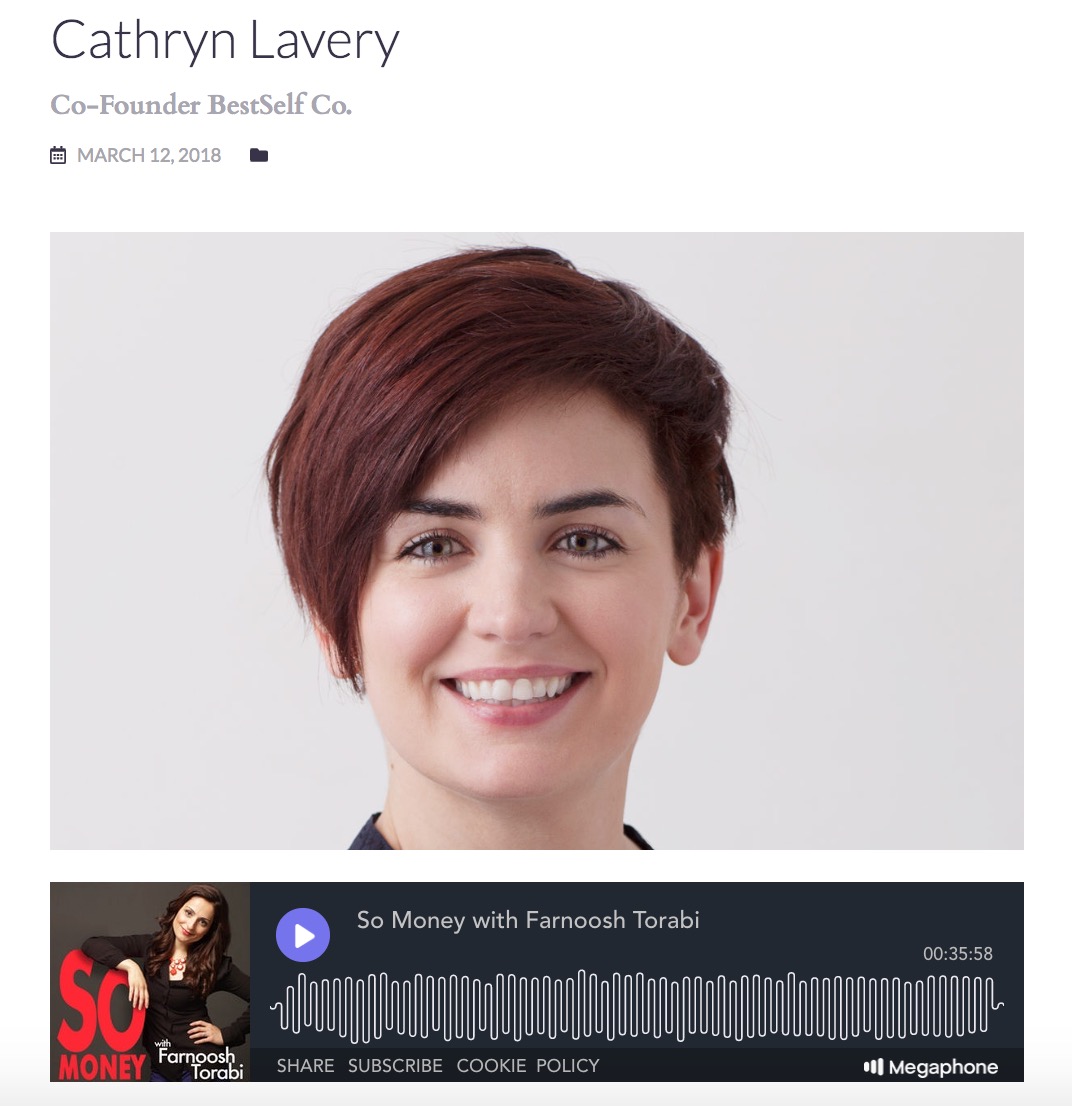
She’s also partnered with people like Nir Eyal for live trainings on Facebook Live:
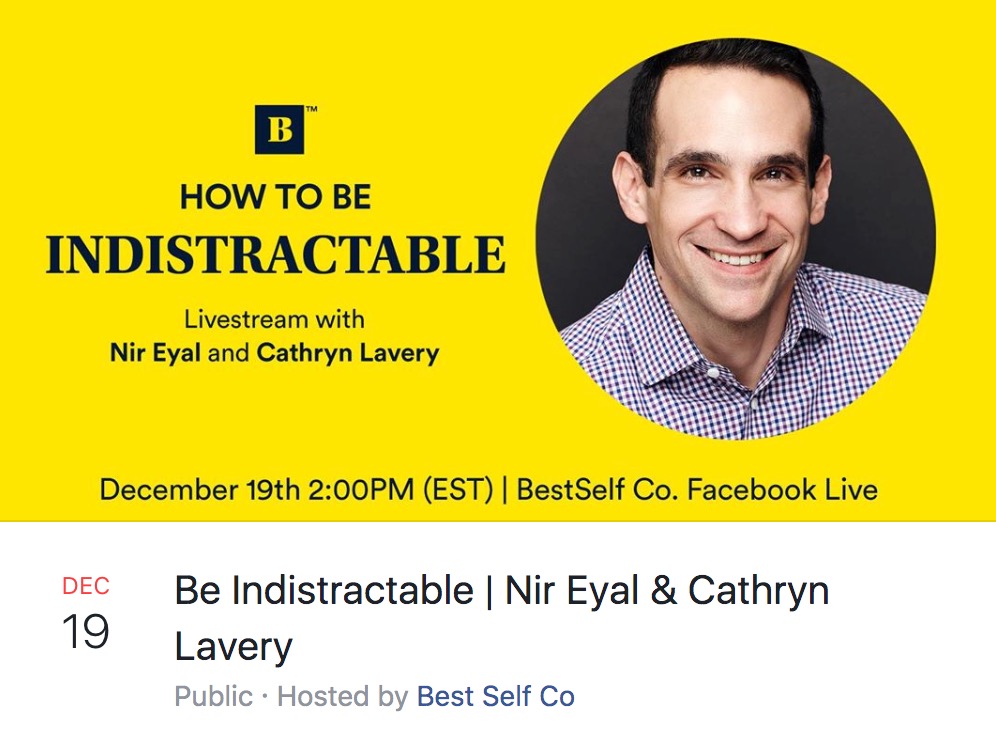
If you’re in eCommerce, look for partners who publish content related to your product’s category. Since you create products that serve that category, you can be an ideal expert for them to feature to their audience.
So the next time you’re tempted to dump money into banner ads or offer online store coupons, stop what you’re doing and execute this partner marketing strategy first.
Get Every Script, Template, and Resource Featured in This Post So You Can Book Your Own Partnerships
Hopefully, this post has given you everything you need to start building your list of ideal partners and sending out your first pitches.
To make that easier, we packaged all the pitch templates and resources featured in this post (including the Dream 50 spreadsheet) into a free downloadable bundle you can access anytime.
 Get it Free Free Download: Get our collection of partnership pitch examples, self-scoring partner spreadsheets, and an email pitch checklist so you can start booking partnerships today.
Get it Free Free Download: Get our collection of partnership pitch examples, self-scoring partner spreadsheets, and an email pitch checklist so you can start booking partnerships today.
Leave a comment and let me know—what type of partnership do you plan on pursuing? What would a successful partnership look like for your business?